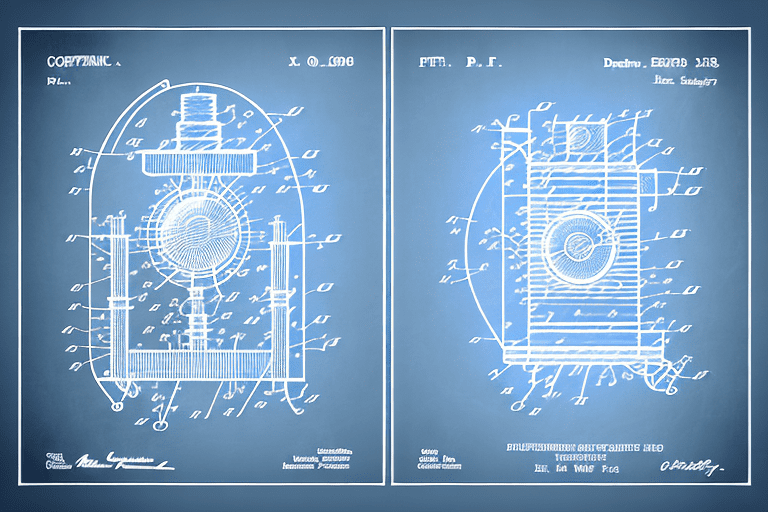In the world of patents, understanding the differences between various types of patents is essential. Two important types of patents are design patents and utility patents. While both provide legal protection for inventions, they differ in their requirements and scope. Specifically, design patents focus on the aesthetic elements of a design, while utility patents protect the functional aspects of an invention. To better comprehend these differences, it is crucial to delve into each patent type and explore how they are applied in various real-world scenarios.
Understanding Patents: A Brief Overview
A patent is a form of intellectual property protection that grants exclusive rights to the inventor or assignee of an invention. It allows them to prevent others from making, using, selling, or importing the invention without consent. Patents encourage innovation by providing inventors with a legal mechanism to profit from their creations.
When it comes to understanding patents, it is important to delve deeper into the concept and explore its various aspects. Let’s take a closer look at what a patent entails and the different types of patents that exist.
What is a Patent?
A patent is a legal right that is granted by a government agency to inventors. It gives them exclusive rights over their invention for a limited period of time, typically 20 years from the filing date. This means that during this time, the inventor has the sole authority to decide who can use, make, or sell their invention.
Patents serve as a crucial tool for inventors to protect their creations and ensure that they can reap the benefits of their hard work. By granting exclusive rights, patents provide inventors with a competitive advantage, allowing them to control the market and potentially profit from their invention.
Different Types of Patents
There are three primary types of patents: utility patents, design patents, and plant patents. Each type of patent serves a unique purpose and offers protection for different aspects of an invention.
1. Utility Patents: Utility patents are the most common type of patent. They protect the functional aspects of an invention. In other words, utility patents cover new and useful processes, machines, compositions of matter, and improvements thereof. These patents focus on the practical application and functionality of an invention.
2. Design Patents: Design patents, on the other hand, safeguard the ornamental appearance of a design. They protect the unique visual characteristics of a product, such as its shape, pattern, or overall appearance. Design patents are often sought by inventors who have created innovative and eye-catching designs that they want to prevent others from copying.
3. Plant Patents: Plant patents cover new plant varieties that have been asexually reproduced. They protect plants that are distinct, uniform, and stable. Plant patents are commonly sought by breeders and horticulturists who have developed new and unique plant varieties through methods such as grafting or cutting.
Understanding the different types of patents is essential for inventors to determine which category their invention falls under and to ensure that they apply for the appropriate form of protection.
In conclusion, patents play a vital role in protecting and promoting innovation. They grant inventors exclusive rights over their creations, allowing them to profit from their inventions and encouraging further advancements in various fields. By understanding the fundamentals of patents and the different types that exist, inventors can navigate the complex world of intellectual property and ensure that their innovative ideas are safeguarded.
Delving into Design Patents
Design patents focus on the aesthetics of an invention rather than its functionality. They provide protection for the unique, non-obvious visual design of a product. Design patents are particularly relevant in industries where the appearance of a product is crucial to its marketability, such as fashion, consumer electronics, and automotive design.
When it comes to design patents, inventors have the opportunity to secure exclusive rights to the ornamental design of an article of manufacture. This encompasses various aspects, including the shape, configuration, surface ornamentation, and overall visual appearance of the design. Unlike utility patents, design patents do not concern themselves with how the design works or its functional aspects.
Understanding Design Patents
A design patent grants the inventor exclusive rights to the ornamental design of an article of manufacture. This includes the shape, configuration, surface ornamentation, and overall visual appearance of the design. Design patents are not concerned with how the design works or its functional aspects.
Design patents play a crucial role in protecting the unique and eye-catching designs that captivate consumers. They allow inventors to safeguard their creations from being copied or imitated by others, ensuring that their innovative designs remain exclusive and distinct in the market.
What Constitutes a Colorable Difference in Design Patents?
In the context of design patents, a colorable difference refers to a difference in appearance that is significant enough to distinguish one design from another. It can include variations in shape, surface pattern, texture, or even the use of color. To be considered a colorable difference, the variation must be noticeable to an ordinary observer and must impact the overall appearance of the design.
When determining whether a colorable difference exists, the perspective of an ordinary observer is crucial. This perspective takes into account the average consumer who would encounter the designs in question. It is important to consider the overall impression created by the design and whether the differences between the designs are substantial enough to be considered unique and distinct.
Designers and inventors must carefully evaluate their designs to ensure that they meet the requirements for a colorable difference. This involves analyzing various elements such as shape, pattern, texture, and color to identify any distinguishing features that set their design apart from existing designs in the market.
Exploring Utility Patents
Unlike design patents, utility patents protect the functional aspects of an invention. They grant the inventor exclusive rights to use, make, sell, or import the invention for a set period of time. Utility patents cover a wide range of inventions, including machines, processes, compositions of matter, and improvements thereof.
When it comes to innovation and technological advancements, utility patents play a crucial role. They provide inventors with the opportunity to protect their groundbreaking ideas and ensure that they have the exclusive rights to capitalize on their inventions. Utility patents are highly valuable assets in today’s competitive market, as they allow inventors to gain a competitive edge and establish themselves as leaders in their respective fields.
One of the key advantages of utility patents is that they protect not only the overall concept or design of an invention but also its functional aspects. This means that inventors can safeguard the way their inventions work and operate, ensuring that others cannot simply replicate their ideas without permission. By granting exclusive rights to use, make, sell, or import the invention, utility patents encourage innovation and reward inventors for their ingenuity.
An Introduction to Utility Patents
A utility patent provides protection for a new and useful process, machine, article of manufacture, or composition of matter. To be eligible for a utility patent, an invention must be novel, non-obvious, and have utility. Utility patents are often sought for inventions that provide new and improved solutions to existing problems.
Obtaining a utility patent involves a thorough examination of the invention’s uniqueness and its potential impact on the industry. Inventors must demonstrate that their invention meets the criteria of novelty, non-obviousness, and utility. This process often requires extensive research, analysis, and documentation to support the patent application.
Once granted, a utility patent provides the inventor with exclusive rights for a specific period of time, typically 20 years from the filing date. During this time, the inventor has the freedom to commercialize their invention, license it to others, or prevent others from using or imitating the patented technology without permission. Utility patents not only protect the inventors’ interests but also contribute to the overall progress and development of various industries.
Defining Patentable Difference in Utility Patents
A patentable difference in utility patents refers to a difference in the functional aspects of an invention that is significant enough to warrant patent protection. It can involve improvements or modifications to the existing technology, resulting in a new and non-obvious invention. To be patentable, the difference must not have been disclosed or obvious to someone skilled in the relevant field at the time of filing.
When assessing patentable differences, examiners consider the level of innovation and the potential impact of the invention on the industry. They analyze whether the proposed modifications or improvements are substantial enough to qualify for patent protection. The goal is to ensure that utility patents are granted to inventions that truly push the boundaries of existing knowledge and contribute to technological advancements.
Patentable differences can range from minor adjustments that enhance the functionality of an existing invention to revolutionary breakthroughs that revolutionize entire industries. By encouraging inventors to explore new possibilities and expand upon existing technologies, utility patents foster a culture of innovation and inspire inventors to continuously push the boundaries of what is possible.
Comparing Design and Utility Patents
While both design and utility patents provide legal protection for inventions, there are key differences between these two types of patents. Understanding these differences is crucial for inventors seeking appropriate patent protection for their creations.
Key Similarities and Differences
One key similarity between design and utility patents is that both types provide exclusive rights to the inventor for a limited period of time. However, they differ in their focus and scope of protection. Design patents protect the unique visual appearance of a design, whereas utility patents safeguard the functional aspects of an invention.
Impact of Colorable and Patentable Differences on Patent Rights
The differences in design and utility patents, specifically colorable differences in design patents and patentable differences in utility patents, have significant implications on patent rights. A colorable difference in a design patent can help establish infringement, whereas a patentable difference in utility patents ensures the novelty and non-obviousness of the invention.
Real-World Examples and Case Studies
To further illustrate the concept of colorable difference in design patents and patentable difference in utility patents, let’s explore some real-world examples and case studies.
Colorable Difference in Design Patents: Case Studies
Case Study 1: In a design patent case involving smartphone designs, a colorable difference was established when one design incorporated a unique pattern on the back cover, whereas another design had a plain back cover. The unique pattern was deemed significant enough to distinguish the two designs and granted the design patent holder exclusive rights to their design.
Case Study 2: In the fashion industry, a colorable difference in a design patent was established when two shoe designs had different surface textures. One had a smooth texture, while the other had a textured pattern. The difference in texture was considered noticeable to an ordinary observer, leading to a colorable difference and exclusive rights for the design patent holder.
Patentable Difference in Utility Patents: Case Studies
Case Study 1: In the pharmaceutical industry, a patentable difference was demonstrated when a new drug formulation was developed, offering improved bioavailability and reduced side effects compared to existing formulations. The novel formulation met the criteria of novelty, non-obviousness, and utility, resulting in the grant of a utility patent.
Case Study 2: For a computer software invention, a patentable difference was established when a new algorithm was developed to solve a complex problem. The algorithm utilized a unique combination of mathematical functions and optimization techniques, resulting in a significantly improved solution. The patentable difference in the algorithm ensured eligibility for a utility patent.
In conclusion, understanding the difference between a colorable difference in design patents and a patentable difference in utility patents is crucial for inventors and those seeking patent protection. Design patents protect the unique visual design of a product, while utility patents safeguard the functional aspects of an invention. By comprehending these differences and analyzing real-world examples, inventors can navigate the patent landscape more effectively and secure appropriate protection for their creations.






